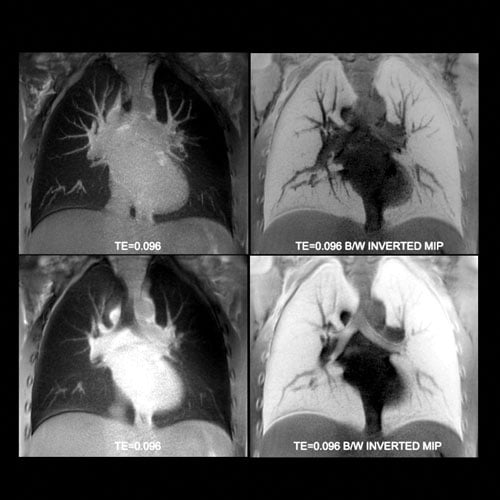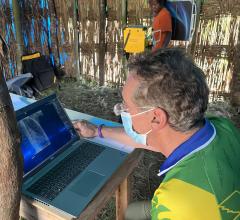
Advanced visualization, such as Toshiba’s ultrashort echo time sequence, promises to make new MR capabilities practical. (Image courtesy of Toshiba America Medical Systems)
It has been said, with melancholy, by the old that youth is wasted on the young. But it is just as bad, if not worse, when wisdom is wasted on the old. Radiology exemplifies the former but, fortunately, not the latter.
In its youth, radiology was brazen, demonstrating ways to look inside the body without breaking the skin, relegating “exploratory surgery” to the trash heap of heroic medicine with its bloodletting devices and leeches. In those early days, radiographers peered inside the body without regard for the exposure of patients to ionizing radiation, as the risks accompanying such exposure were not known.
Just as X-rays, nuclear medicine and ultrasound threw back the sash, digital advances — first computed tomography (CT), then magnetic resonance (MR) — have increased the clarity that came from looking through that window. Since this modern age of medical imaging dawned, particularly over the last decade, the dangers of ionizing radiation have come into focus. Research and development (R & D) has helped rein in those dangers both by refining the techniques that use ionizing radiation and finding ones that eliminate its need.
The evolution of advanced visualization, particularly as it relates to MR, is an eye-opener in this regard. This technology, which began as a complement to picture archiving and communication systems (PACS), is today a multifaceted capability with applications particularly relevant to MR, one that is changing both the clinical reach and use of this modality.
For decades, MR operations have followed a formula built around timeslots. As demand rose, administrators increased the number of slots, just as radiologists and techs leverage the more efficient and expansive capabilities of this modality.
Today, with the encroachment of value medicine and the diminished ability to extend the workday, the need to get more from what can be done within the current framework is palpable.
Advanced visualization is both accentuating this need for increased efficiency and providing the means for achieving it.
New techniques and protocols for MR abdominal scanning, as well as for the prostate, are inviting more patients into the MR suite, promising to boost volume beyond the steady historical growth that has been achieved through conventional applications. These new growth opportunities are underscored by advances shown at RSNA 2015, particularly how MR might be used to examine the heart, utilizing GE’s Health Cloud, and even the lungs thanks to an ultrashort echo time sequence developed by Toshiba. In an age of heightened concerns about ionizing radiation, the growth potential of such applications — MR lung in place of CT, and MR cardiac in place of cardiac cath — is clear.
At the same time, developments in advanced visualization promise to reduce the time required to perform bread-and-butter MR. Two such developments from Siemens introduced at RSNA 2015, GoBrain and Simultaneous Multi-Slice (SMS), exemplify this.
GoBrain allows the acquisition in just five minutes of neuro data for images that can be reformatted in multiple orientations and at varying contrasts. SMS reduces the time for an MR scan by simultaneously exciting and recording data to be reformatted into multiple slices of the brain. Also at RSNA 2015, Philips demonstrated how its latest version of modified Dixon (mDixon) could accelerate MR scans, just as the company’s ScanWise showed how patients with MR implants could be handled to reduce or eliminate artifacts efficiently and effectively.
These are only the latest examples of efforts that have focused on making MR faster, better and more clinically useful. Speed is the common denominator, making the management of patients more efficient and their handling more patient centric.
In short, advanced visualization is the catalyst that is bringing information and imaging technologies together.
The goal of value medicine — to reduce the cost of patient management without degrading quality of care — aligns well with R & D now underway. It promises to provide both the time and the money needed to take better care of the increasing numbers of patients likely to show up at healthcare’s door in the future.
With a century of experience, radiology has grown wise in both the advantages that its technologies bring and the dangers that accompany their use. Advanced visualization has provided the means to advance the modern causes of radiology, dictated by the wisdom that the imaging community has achieved.
Greg Freiherr has reported on developments in radiology since 1983. He runs the consulting service, The Freiherr Group. Read more of his views on his blog at www.itnonline.com.
Editor’s note: This column is the culmination of a series of four blogs by industry consultant Greg Freiherr on MR Balances Speed and Clinical Reach. The blogs, “MR is About to Get Faster, Cheaper and More Valuable: It’s About Time,” “The Unsettling Evolution of Advanced Visualization,” “How Increased Productivity Might Pave the Way to Personalized Medicine” and “Advanced Visualization and the Future of MR,” can be found at www.itnonline.com/blogs.


 April 13, 2024
April 13, 2024 








